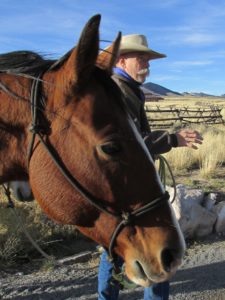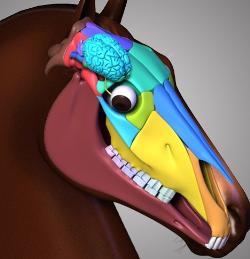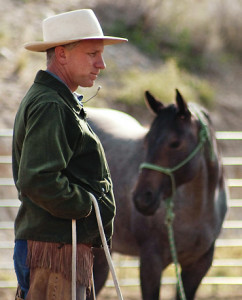By Maddy Butcher
“Your circle of comfort and your horse’s circle of comfort – they must constantly expand, otherwise they will shrink.”

Randy Rieman
That’s what horseman Randy Rieman told me. And here I was thinking I could hang out in comfort, where my horse and I would coexist blissfully and enjoy a lifetime of happy riding. Turns out, it ain’t so. Turns out, we must experience some discomfort in order to appreciate comfort.
What is comfort?
- Comfort is a place, a situation, a feel where nothing bad ever happens.
- Comfort can be a protected environment or a state of mind.
We can all be guilty of keeping our horses in that perpetual comfort circle, where nothing is allowed to rile them. But, according to many interviewed clinicians, women are especially prone to it.
Why?
We tend to be nurturers by nature. The warm and fuzzies are what we have to offer our friends, our children, our animals.
We often respond to big horsey challenges with fear and its cousin, a lack of confidence. Staying in comfort is one way to avoid these negative emotions.
But good horsemanship and science meet here:
- Comfort, like comfort food, isn’t always good for you.
- Give your horses too much of it, and they will be worse off.

Horses new to cows may get riled, especially at first
Comfort has its neurological home in the autonomic nervous system. This brain feature is responsible for parasympathetic (“rest & digest”) and sympathetic (“fight or flight”) responses as well as homeostasis, the system’s ability to maintain internal stability. That’s the closest scientific term for what we call comfort. If you think of homeostasis in terms of temperature, it’d be that office-friendly, 70 degrees.
The hypothalamus, part of the brain located under the thalamus in all mammals, is the modulator or thermostat for homeostasis.
In the Evidence Based Horsemanship diagram (at right), Peters and Black describe the ideal learning environment as one that takes the horse to a state just outside its comfort range.
It’s a place where:
- the horse feels curious and a bit concerned
- the horse’s ears and eyes will be alert; its head will be above its withers
Ideally, when that moment of learning (and discomfort) is over, the horse will automatically return to its homeostasis and there will be a rush of dopamine (one of the brain’s feel-good neurochemicals). It’s the rainbow after the storm.
Oh, what a feeling!
Horses, like all mammals, crave dopamine. But they don’t get it without feeling stressed first.
“If you never get a horse out of his comfort zone, he’s never going to seek comfort. I help riders learn how to find that dopamine release with their horses,” said Black.
 Turns out our homeostasis range or comfort zone can expand or shrink depending on our exposure to different situations and settings and how we manage there.
Turns out our homeostasis range or comfort zone can expand or shrink depending on our exposure to different situations and settings and how we manage there.
“Sometimes, with your riding, you have to show your horses that they can live through panicky situations,” added Dr. Peters. “They won’t be reliable unless you put them in those situations and offer them a chance to find comfort or a way back to homeostasis on their own. They will grow and learn when exposed to more situations outside their comfort. But the range of their homeostasis will be very small, if we insist on keeping them there.”
Read more about Optimal Learning.
What about Rider Fear?
It’s up to us humans to overcome whatever issues we have with our own comfort and discomfort, in order to do what’s best for our horses.
In the opening clip of 7 Clinics with Buck Brannaman, the Ray Hunt protégé says:
“Fear is a big thing that just owns some people. It can be overwhelming,” he said.
Brannaman implores his students to work with their horses at full speed and to learn how to use flexion and the one-rein stop. Read more about bolting and rider fear here.
“You do need to get a horse to where you can open him up and go. A horse is pretty incomplete if you can’t just open him up and not have him lose his mind. I like to practice dialing him up and dialing him back down.”
Or as the Italian poet, Dante, said some 700 years ago, “We must overact in some measure, in order to produce any effect at all.”
Read more about Optimal Learning.

Nice to see someone addressing the fear angle in horses. I used to spook my horses till they quit reacting to the spook. Be it an umbrella, water, balloon, etc. Have had some people nag me about how “mean” I was because of what I did. Know what. My horses were practically spook proof. On occasion they would become alert, but did not bolt, shy away or run. I always had a great ride.
If you don’t push their envelope, they’ll never learn. If you push their envelope so far that it tears, you’ll never be able to glue it perfectly back together again. Or, the learning process always involves some degree of stress. the teacher’s job is to NOT exceed the stress threshold.
What a load of crap!
Shaking my head in disbelief!
It is common knowledge that stress hormones inhibit cognition.
What will the roundpenners think up next to make a buck????
How about a magic round pen that dispels fear stimuli in the Amygdala?
http://bigthink.com/going-mental/how-the-brain-fears
http://nymag.com/scienceofus/2015/07/everybody-misunderstanding-fear-and-anxiety.html
http://www.emotions-r-us.com/
http://veterinarynews.dvm360.com/fear-free-veterinary-neurologist-s-perspective
Thanks for your comment and links, Chuck. Based on the links you provided, I think we agree more than you realize. For instance, we are not advocating training through fear or increasing the level of cortisol or engaging the amygdala hyperactively. Of course, panicked animals (humans included) cannot think.
But animals that are never asked to leave their homeostasis or comfort zone don’t make progress.
Here’s another piece you might find interesting:
http://horsehead.info/close-encounters-with-the-amygdala/
You’re mixing things up, Chuck. There’s a huge difference between round-penning a horse thus sending his cortisol level flying and taking him just shy of their comfort zone. Learning never happens when you don’t dip your foot in the water.
Baloney!
You don’t need a round pen or ANY type of restriction. In fact, just the opposite!
ALL my ‘training’ is done in an open pasture from start to finish.
Is there any evidence (beyond a Buck anecdote) to support the graphic? Does this assume training by negative reinforcement only?
Thanks for your question, Patricia. The graphic I think you refer to is an extrapolation/illustration of elements of the autonomic nervous system. The parasympathetic (“rest and digest”) and the sympathetic (fight or flight). The autonomic nervous system is widely taught in college biology classes, for instance. Does this help?
It shows an area labeled “Optimal Learning”. What is the evidence to designate it as such?
Thanks for your question, Patricia. Animals, including horses and humans, learn best when they are not fatigued, disinterested, or bored AND not scared, panicky, or upset. Optimal learning occurs between these two states. For more on you might check out our sister site, HorseHead.info And here’s an article on Optimal Learning http://besthorsepractices.com/seeking-ltp-optimal-learning/ Maddy Butcher
The Buck thing isn’t an anecdote. Dialing horses up and down is something he advocates on a general basis. His point is to get horses emotionally fit so that they don’t freak out every time you ask for more action. Let’s be honest: as a trail rider, I know LOTS of people who daren’t gallop their horses because they can’t calm them down for an hour after that.
I think that quoting BB here is somewhat confusing since the article is mainly about something very different: taking horses just outside their comfort zone so that learning takes place. What Buck says is that horses should be able to easily move from one level of energy to another.
Yes, it is most likely true that stress has the potential to be positive. It is equally important to titrate this so that the horse, and/or the human, has the opportunity to meet stress in healthy ways on a physiological level. You might want to do some research on Polyvagal theory to expand your awareness and understanding of what is happening in the ANS, why it is happening, and how to build true resiliency in the horse (and ourselves). Your illustration and what are sharing is an over simplification of the ANS, and not entirely accurate. As mammals, we ALWAYS want the ANS to be in homeostasis/balance/flow and social engagement, whether we are in state of acceleration (SNS) or the brake is on (PNS). A more accurate illustration for building resiliency in the ANS would be a bell shaped curve, where the horse begins in a calm state, is able to meet the physiological emotional and psychological demands of a new or potentially threatening situation while maintaining social engagement the entire time (and by entering into a flow state), and then return to calm and spend time in a restorative state. Without this return to relaxation and calm – we are setting things up for the stress to become lodged as trauma in the body. There is some great information available about this – and the important steps involved when we (or the horse) face a challenge or stressful situation. How we are able to respond will determine whether we go into fight/flight or worse (mobilization/SNS)- freeze/overwhelm (inanimation/PNS), or where we want to be – in flow (balance between the two). There is no one size fits all of course. Depending on the trauma background of a horse, and/or a human, the body may or may not be able to respond in a healthy or positive way to stress. To be effective, it is important to be able to read the subtle horse, or human, cues that show us what is happening on a physiological level.
Do you have a favourite source that anlyses horses in polyvagal terms?